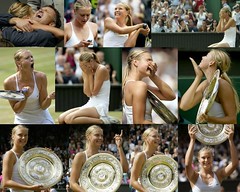History of Wimbledon
The Championships, Wimbledon, commonly referred to as Wimbledon, is the oldest major championship in tennis and is regarded by many to be the most prestigious tennis championship in the world.
Held annually between late June and the beginning of July for two weeks (usually ending, at the latest, on the second Sunday of July) at the All England Lawn Tennis and Croquet Club in London, England, the tournament is the third Grand Slam event played each year, preceded by the Australian Open and the French Open, and followed by the U.S. Open. The tournament duration is subject to extensions for rain.
Separate tournaments are simultaneously held, all at the same venue, for Gentlemen's Singles, Ladies' Singles, Gentlemen's Doubles, Ladies' Doubles and Mixed Doubles. Youth tournaments – Boys' Singles, Girls' Singles, Boys' Doubles and Girls' Doubles – are also held. Additionally, special invitational tournaments are held: the 35 and over Gentlemen's Doubles, 45 and over Gentlemen's Doubles, 35 and over Ladies' Doubles and wheelchair doubles.
The Beginning
The All England Lawn Tennis and Croquet Club, which is responsible for staging the world's leading tennis tournament, is a private Club founded in 1868, originally as 'The All England Croquet Club'. Its first ground was situated off Worple Road, Wimbledon.
In 1875 lawn tennis, a game introduced by major Walter Clopton Wingfield a year or so earlier and originally called 'Sphairistike', was added to the activities of the Club. In the spring of 1877 the Club was re-titled 'The All England Croquet and Lawn Tennis Club' and signalled its change of name by instituting the first Lawn Tennis Championship. A new code of laws, hitherto administered by the Marylebone Cricket Club was drawn up for the meeting. These have stood the test of time and today's rules are similar except for details such as the height of the net and posts and the distance of the service line from the net.
The only event held in 1877 was the Gentlemen's Singles which was won by Spencer Gore, an old Harrovian rackets player, from a field of 22. About 200 spectators paid one shilling each to watch the final.
The lawns at the Ground were arranged in such a way that the principal court was situated in the middle with the others arranged around it; hence the title 'Centre Court', which was retained when the Club moved in 1922 to the present site in Church Road, although not a true description of its location. However, in 1980 four new courts were brought into commission on the north side of the ground, which meant the Centre Court was once more correctly defined. The opening on the new No. 1 Court in 1997 emphasised the description.
By 1882 activity at the Club was almost exclusively confined to lawn tennis and that year the word 'croquet' was dropped from the title. However, for sentimental reasons, it was restored in 1899 and since then the title has remained 'The All England Lawn Tennis and Croquet Club'.[2]
The Championships were first played under the control of the All England Lawn Tennis and Croquet Club in 1877 at a ground near Worple Road, Wimbledon; the only event held was Gentlemen's Singles. In 1884, the All England Club added Ladies' Singles and Gentlemen's Doubles. Ladies' Doubles and Mixed Doubles were added in 1913. The Championships moved to their present location, at a ground near Church Road, in 1922. As with the other three Grand Slam events, Wimbledon was contested by top-ranked amateur players until the advent of the open era in tennis in 1968. Britons are very proud of the tournament, though it is a source of national anguish and humour – no English man has won the singles event at Wimbledon since Fred Perry in 1936, and no English woman since Virginia Wade in 1977. The Championship was first televised in 1937.
Wimbledon in the 21st Century
Wimbledon is acknowledged to be the premier tennis tournament in the world and the priority of The All England Lawn Tennis Club, which hosts The Championships, is to maintain its leadership into the twenty-first century. To that end a Long Term Plan was unveiled in 1993, which will improve the quality of the event for spectators, players, officials and neighbours.
Stage one of the Plan was completed for the 1997 Championships and involved building in Aorangi Park the new No. 1 Court, a Broadcast Centre, two extra grass courts and a tunnel under the hill linking Church Road and Somerset Road.
Stage two involved the removal of the old No. 1 Court complex to make way for the new Millennium Building, providing extensive facilities for the players, press, officials and Members, and the extension of the West Stand of the Centre Court with 728 extra seats.
Stage three continues. The construction of a new Championships entrance building, housing Club staff, museum, bank and ticket office at Gate 3 has left the Centre Court east side empty and will allow development to provide better facitilies for the public, increase the seating capacity from 13,800 to 15,000 and erect a retractable roof.
Credit: Wikipedia



No comments:
Post a Comment